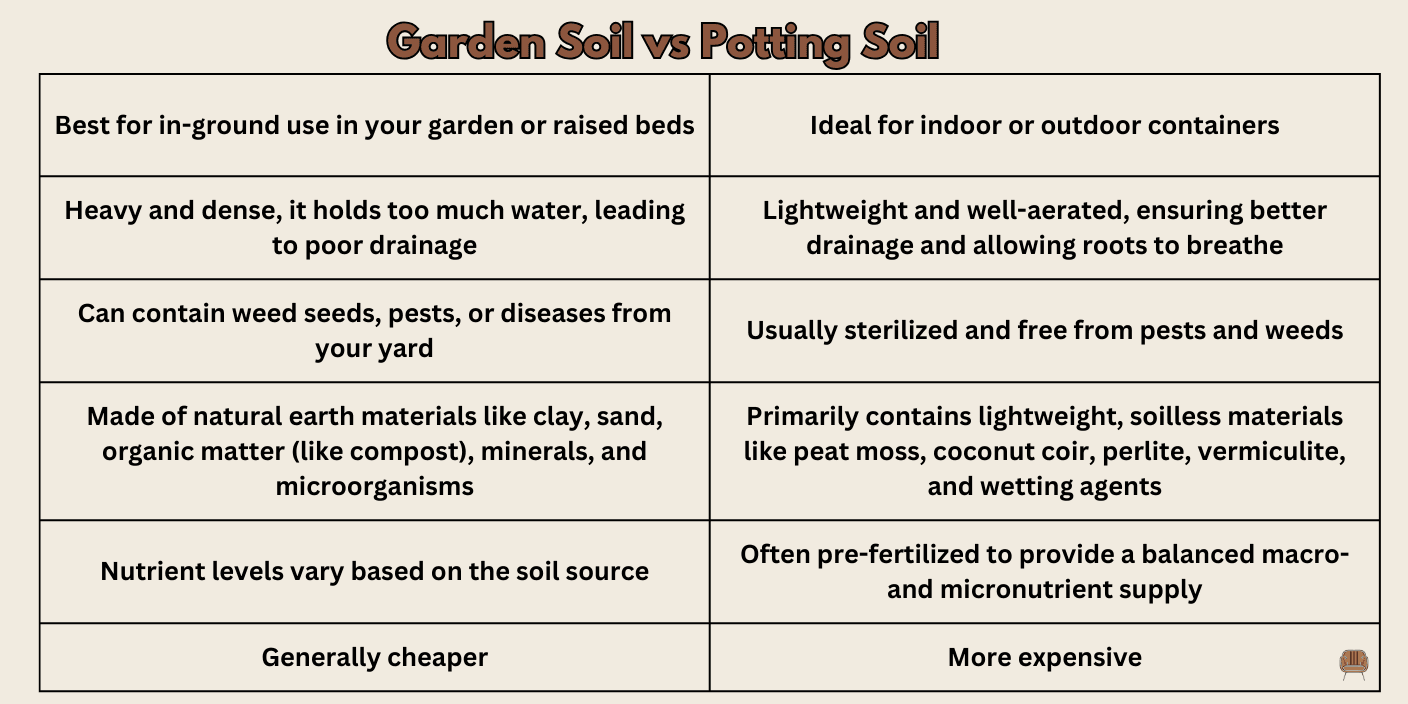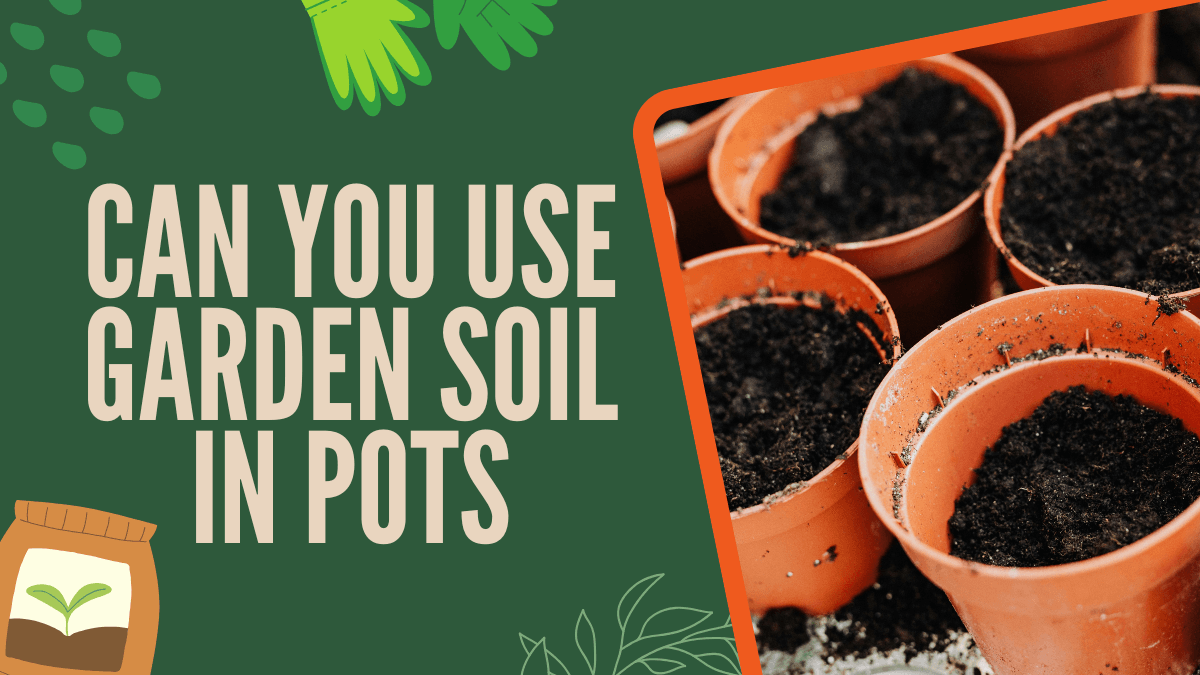One of the most common questions I asked in the past is, “Can you use garden soil in pots?” Yes, you can use garden soil in pots, but it’s not recommended because it can be too heavy, may not drain well, and could lead to root rot or pest issues.
The answer might seem easy to experienced gardeners, but for beginner gardeners (myself included, years ago), it was far from simple to understand the difference. I used to think, “It’s just soil“ even though the garden soil appeared quite unappealing and seemed to lack something essential.
In contrast, potting mixes looked so soft and well-aerated, had a good consistency, and seemed rich in various nutrients. I could see there was a difference, but I still needed to learn the essence of what set them apart.
If you’re new to gardening, see my full guide: How to Start Gardening for Beginners
What is garden soil?
Garden soil is typically the soil you have in your yard. It’s often a mix of natural soil (clay, silt, peat, and sand) along with organic matter like decomposed leaves, manure, and plant material. This type of soil can vary widely depending on where you live.
For example, my garden soil is rich, soft, and peaty, perfect for growing veggies, but in my village house, the soil is very rocky and loamy and is so hard to process.
What is potting soil?
Potting soil, on the other hand, is specially formulated for container gardening. It usually consists of peat moss, vermiculite, perlite, compost, fertilizer, and sometimes coconut coir or bark.
These ingredients provide excellent drainage, aeration, and moisture retention qualities that are important for potted plants. Think of potting soil as a customized blend designed to give your potted plants the best possible start.
The Pros and Cons of Using Garden Soil in Pots
So, can you use garden soil in pots? Yes, why not? But in my opinion, this may be a temporary solution, and it depends on what kind of soil you have.
However, let’s consider some pros and cons so you can decide for yourself what works best for your needs.

Pros of Using Garden Soil in Pots
- Cost-effective: If you have a lot of garden soil, it’s a great way to save money instead of purchasing potting soil.
- Nutrient-rich: Your garden soil may contain beneficial nutrients and microorganisms that can help your plants thrive.
- Less Waste: Using garden soil can help reduce waste if you have extra soil from other landscaping projects.
Cons of Using Garden Soil in Pots
- Compaction: When garden soil is packed into a container, it often compresses, reducing the air pockets essential for root health. Compacted soil can suffocate roots, making it harder for plants to absorb water and nutrients. I learned this when I used garden soil in my potted plants, resulting in waterlogged roots and heavy soil.
- Weeds and Pests: Garden soil may contain pests, weed seeds, or pathogens that can harm potted plants. These unwanted guests can create additional challenges for maintaining healthy plants. I once found a surprise colony of ants in a pot filled with garden soil.
- Nutrient Imbalance: Garden soil can be nutrient-rich, but its composition can vary significantly based on location. This inconsistency may not provide the balanced nutrients that potted plants require, leading to nutrient deficiencies or toxicities.
What are the effects of using garden soil in pots?
While it’s possible to use garden soil in pots by amending it with organic matter, sand, or perlite, it’s generally not recommended.
Garden soil is excellent for outdoor use in natural settings, where it can integrate with existing soil but can also compact, retain too much moisture, and may introduce pests or weeds.
Potting soil with its specialized properties is ideal for containers and indoor plants, offering better drainage, aeration, and a pest-free environment for healthy plant growth.
By using garden soil in pots, you risk creating an environment that is detrimental to your plant’s health. Opting for a quality potting mix is a better choice for container gardening.
Let’s check several potential issues:
- Inconsistent Quality: The quality of garden soil can vary greatly. You might unknowingly bring in pathogens or diseases that can harm your potted plants.
- Water Retention Issues: Depending on the type of garden soil, it may retain too much moisture, making it difficult for plants that prefer drier conditions to thrive. Conversely, some garden soils may dry out too quickly in pots.
- Weight: Garden soil is typically heavier than potting soil, which can make pots bulky and difficult to move, especially when filled.
Best practices for using garden soil in pots
If you decide to use garden soil in pots, there are some best practices to keep in mind to ensure your plants stay healthy.
1. Mix It Up
Instead of using pure garden soil, consider mixing it with potting soil or other revisions. A 30/70 blend (30% garden soil and 70% potting soil) is a good starting point. This helps improve drainage and aeration while still providing the nutrients from the garden soil.
Soil Mix Recipe for Pots:
You can create your potting mix at home!
- 30% Garden Soil (provides natural nutrients)
- 50% Potting Soil (lightens the mix, helps with drainage, and adds extra nutrients)
- 20% Organic Matter (compost or well-rotted manure; adds additional nutrients and improves moisture retention)
- 1-2 handfuls of Perlite or Vermiculite (improves aeration and drainage)
- 1-2 handfuls of coarse sand (not fine; improve drainage and prevent becoming too soggy)
- 1 handful of Coconut Coir or Peat Moss (adds moisture)
Mix thoroughly, and you’re ready to plant! Check the consistency. The mix should be light, well-draining, and slightly moist, not too dry or too soggy. This basic recipe improves drainage while still providing the nutrients from garden soil.
2. Sterilize the Soil
To minimize the risk of pests and diseases, you can sterilize your garden soil before using it. Spread it out on a baking sheet and bake it at 180°F (82°C) for about 30 minutes. This will kill most pathogens and pests, giving you a cleaner soil mix.
3. Check for Compaction
When filling your pots with garden soil, make sure not to pack it down too tightly. Leave some space for air to circulate around the roots. I always lightly fluff the soil before placing my plants in to encourage good drainage.
4. Monitor Watering Needs
Potted plants often have different watering needs than those planted directly in the ground. Keep an eye on moisture levels, as garden soil can retain water longer than potting soil. Make adjustments as needed.
What can you add to your mix to boost aeration and drainage?

1. Perlite
Perlite is incredibly lightweight, making it easy to handle and mix into soil. I love this ingredient. Its porous structure creates numerous air pockets, which help prevent soil compaction. This allows for better root aeration and encourages healthy plant growth. Additionally, perlite doesn’t retain water, ensuring that excess moisture drains away efficiently.
2. Vermiculite
Vermiculite not only improves drainage but also retains moisture, making it an excellent choice for maintaining a balanced water supply. Its unique structure allows it to hold water and nutrients while still providing good aeration. This helps prevent over-watering and keeps the soil environment suitable for plant roots.
3. Coconut Coir
Coconut coir is a sustainable material that enhances soil structure. Coconut coir is a fantastic alternative to peat moss and is more sustainable. It improves aeration and water retention, allowing roots to access moisture without becoming waterlogged. This organic matter also contributes to a healthy soil ecosystem, encouraging beneficial microbial activity that supports plant growth.
4. Sand
Coarse sand creates larger spaces between soil particles, which improves drainage and reduces compaction. This is particularly beneficial for plants that thrive in drier conditions, as it prevents excess moisture from surrounding the roots. Sand also helps keep the soil loose, allowing roots to expand freely.
5. Bark Chips
Bark chips provide excellent aeration due to their larger size and irregular shape, which creates spaces in the soil. As they break down over time, they also contribute organic matter and nutrients, enriching the soil. The structure of bark chips allows for improved drainage, making them ideal for container gardening.
6. Gravel or Pebbles
Adding a layer of gravel or pebbles at the bottom of pots enhances drainage by allowing excess water to escape quickly. This prevents root rot and other water-related issues. Gravel is especially useful in heavy soils, as it provides a stable base that promotes good drainage and keeps soil from washing away.
7. Rice Hulls
Rice hulls are lightweight and help improve soil aeration and drainage while being environmentally friendly. They decompose slowly, adding organic matter to the soil over time. Rice hulls also help reduce soil compaction, creating a healthy environment for roots to grow in.
What can you add to improve moisture retention in your mix?

1. Peat Moss
Peat moss is highly absorbent and can hold several times its weight in water, making it an excellent moisture-retentive material. It helps maintain a consistent moisture level in the soil, reducing the frequency of watering. Additionally, peat moss improves soil structure and encourages healthy root growth by providing a slightly acidic pH, which many plants prefer.
2. Coconut Coir
Coconut coir, made from the husks of coconuts, retains moisture well while providing good aeration. It holds water effectively without becoming waterlogged, making it a sustainable alternative to peat moss. Coir also contains natural growth hormones that promote root development, making it beneficial for young plants.
3. Vermiculite
Vermiculite is a mineral that expands when heated, creating a lightweight, sponge-like material that retains moisture. It helps keep the soil consistently moist while improving aeration. Vermiculite is also pH neutral, which means it won’t alter the acidity of your soil mix, making it suitable for a wide variety of plants.
4. Hydrogel Crystals
Hydrogel crystals are superabsorbent polymers that can hold large amounts of water and release it slowly to the plants. When mixed into the soil, they help maintain moisture levels, reducing the need for frequent watering. Hydrogel is especially useful in dry climates or for plants that require consistent moisture. I often use it to grow a variety of plants.
5. Compost
Compost not only adds nutrients to the soil but also improves its ability to retain moisture. The organic matter in compost helps the soil hold water more effectively, providing a steady supply of moisture to plant roots. Additionally, compost improves the soil with beneficial microbes that support healthy plant growth.
6. Sphagnum Moss
Sphagnum moss is known for its excellent moisture retention abilities. It absorbs water and helps keep the soil moist, making it particularly useful for plants that thrive in moist conditions. Sphagnum moss also provides a lightweight option that enhances aeration when mixed with other soil components.
7. Mulch
Organic mulch, such as shredded bark or straw, can be applied to the soil in pots to help maintain consistent moisture levels. It reduces evaporation, keeps the soil temperature stable, and slowly breaks down to add organic matter to the soil. This creates a more favorable environment for roots.


 ChatGPT
ChatGPT
 Perplexity
Perplexity
 Claude
Claude

Leave a Reply